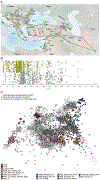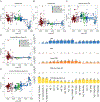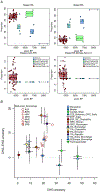The genetic history of the Southern Arc: A bridge between West Asia and Europe
- PMID: 36007055
- PMCID: PMC10064553
- DOI: 10.1126/science.abm4247
The genetic history of the Southern Arc: A bridge between West Asia and Europe
Abstract
By sequencing 727 ancient individuals from the Southern Arc (Anatolia and its neighbors in Southeastern Europe and West Asia) over 10,000 years, we contextualize its Chalcolithic period and Bronze Age (about 5000 to 1000 BCE), when extensive gene flow entangled it with the Eurasian steppe. Two streams of migration transmitted Caucasus and Anatolian/Levantine ancestry northward, and the Yamnaya pastoralists, formed on the steppe, then spread southward into the Balkans and across the Caucasus into Armenia, where they left numerous patrilineal descendants. Anatolia was transformed by intra-West Asian gene flow, with negligible impact of the later Yamnaya migrations. This contrasts with all other regions where Indo-European languages were spoken, suggesting that the homeland of the Indo-Anatolian language family was in West Asia, with only secondary dispersals of non-Anatolian Indo-Europeans from the steppe.
Figures






Comment in
-
Ancient genomes and West Eurasian history.Science. 2022 Aug 26;377(6609):922-923. doi: 10.1126/science.add9059. Epub 2022 Aug 25. Science. 2022. PMID: 36007032
References
-
-
Detailed information is provided in the supplementary materials
-
-
- Allentoft ME et al., Population genomics of Bronze Age Eurasia. Nature 522, 167–172 (2015). - PubMed
Publication types
MeSH terms
Grants and funding
LinkOut - more resources
Full Text Sources
Research Materials

